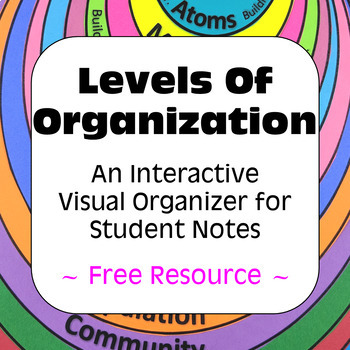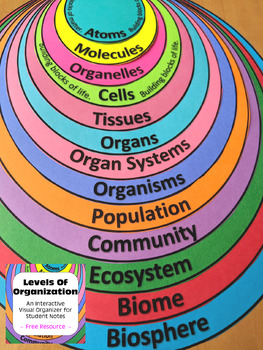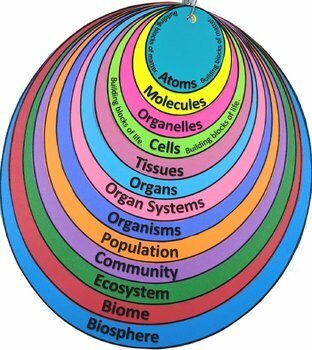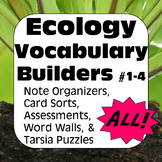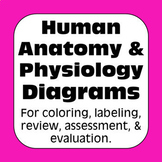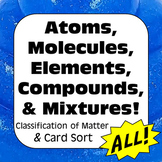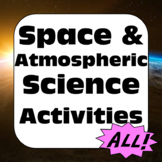Levels of Organization From Atoms to Biosphere Interactive Note Organizer
- PDF
- Easel Activity
Also included in
- Ready for a wild ride through the world of elements? Buckle up, educators, because we've got a Periodic Table Scavenger Hunt that'll make your students' heads spin faster than a noble gas!Introducing our Non-Traditional, Student-Friendly, Periodic Table-Friendly, and Downright Awesome Introduction tPrice $27.90Original Price $31.00Save $3.10
- Combine science and literacy into two very educational worksheets! Given short descriptions of common everyday chemical reactions, students identify reactants and products to write the word equation and chemical equation for each.An introductory version of this activity can be found here: Writing CPrice $4.00Original Price $5.00Save $1.00
- Knowledge of terms is essential when studying ecology. To help students build their vocabulary, this handy note organizer groups selected terms strategically to help your students understand and differentiate between them. Assessment quiz and word wall posters included.Also included, two different hPrice $25.20Original Price $28.00Save $2.80
- Ready to zoom down to the molecular level and make the world of elements, compounds, and mixtures come alive for your students? Introducing two essential tools that will turn your classroom into a fun and easy exploration of the classification of matter!First, dive into the difference between atomsPrice $12.15Original Price $13.50Save $1.35
- Anatomy and physiology, human body system diagrams perfect for coloring, labeling, review, assessment, and evaluation.Includes the brain, the heart and cardiovascular system, digestive system, respiratory system, urinary system, animal cell and plant cell.Please see individual files included in thisPrice $16.20Original Price $18.00Save $1.80
- Zoom down to the molecular level to visualize the different between elements, compounds, & mixtures, and organize your notes with handy flowchart style graphic organizers; two essential tools to equip yourself with when starting a journey into the classification of matter.Then, with this firm foPrice $22.05Original Price $24.50Save $2.45
- A bundle of activities for Ecology, Environmental Studies, and Earth Science.Please see individual files for additional details. ⭐Click here to follow my store & receive the latest updates.Original Artwork (©AwesomeScience). For Personal Use Only. Uneditable.Page count does not include Terms ofPrice $47.10Original Price $52.33Save $5.23
- A bundle of activities for space science and atmospheric science students.Please see individual files for additional details.Click here to follow my store and receive the latest updates.Original Artwork (©AwesomeScience). For Personal Use Only. Uneditable.Page count does not include Terms of Use andPrice $9.45Original Price $10.50Save $1.05
- A bundle of activities for plant biology - botany - students.Please see individual files for additional details.Click here to follow my store and receive the latest updates.Original Artwork (©AwesomeScience). For Personal Use Only. Uneditable.Page count does not include Terms of Use and links to supPrice $6.15Original Price $6.83Save $0.68
Description
The original interactive, visual tool designed to illustrate the relationship between atoms, molecules, organelles, cells, tissues, organs, organ systems, organisms, population, community, ecosystem, biome, and biosphere.
Also serves as a handy note organizer for your students.
Answers not included.
Click here to follow my store and receive the latest updates.
Original Artwork (©AwesomeScience). For Personal Use Only. Uneditable.
Page count does not include Terms of Use and links to supplementary activities.
Copyright ©AwesomeScience 2018 – The Present.
All Rights Reserved by Author.
By using this Resource you agree to the Terms as outlined in the Terms of Service. This Resource is for limited Personal Use only; not to be used, in part or in whole, for commercial purposes. Each Individual License is for use by one specific educator only. Additional licenses must be purchased for each additional educator. Except as permitted in Section 3 to deliver Resources electronically to Permitted Recipients, you may not post or otherwise make the Resource available on any website, application, shared drive or other sites or services.

